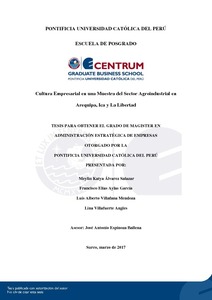| dc.contributor.advisor | Espinoza Ballena, José Antonio | |
| dc.contributor.author | Álvarez Salazar, Meylin Katya | es_ES |
| dc.contributor.author | Aylas García, Francisco Elías | es_ES |
| dc.contributor.author | Villafana Mendoza, Luis Alberto | es_ES |
| dc.contributor.author | Villafuerte Angles, Lina | es_ES |
| dc.date.accessioned | 2017-04-12T00:22:46Z | |
| dc.date.available | 2017-04-12T00:22:46Z | |
| dc.date.created | 2017 | |
| dc.date.issued | 2017-04-12 | es_ES |
| dc.identifier.uri | http://hdl.handle.net/20.500.12404/8433 | |
| dc.description.abstract | En la última década el Perú ha crecido de manera exponencial en el sector agrícola,
generando una gran fuente de trabajo en las localidades de Arequipa, Chincha y Trujillo, y
con ello, se dio una ola de generación de nuevas empresas que se han constituido como parte
de este crecimiento. Esto ha llevado a contratar personas de cada localidad, quienes vienen
con propias costumbres e idiosincrasia la cual ha sido heredada en el tiempo. Adaptarse a un
cambio laborando en una empresa agroindustrial puede conllevar algunos conflictos, debido a
que la empresa desea desarrollar una cultura organizacional la cual los colaboradores deben
de incorporar en el día a día, generando armonía en el ambiente laboral y desempeño de los
grupos humanos que laboran en la institución.
El modelo de Kim, Cameron y Quinn ha ayudado a las organizaciones, a través del
instrumento OCAI “ The Organization Culture Instrument”, a definir las características de
los colaboradores para el diseño de estrategias en la gestión de los recursos con los que se
cuenta. Se realizó una investigación sobre la cultura organizacional predominante en
empresas del sector agrícola, donde se analizó 94 encuestas, agrupadas en tres sub muestras
que corresponden a las tres unidades organizativas de una misma organización, ubicadas en
Arequipa, Chincha y Trujillo. Como resultado, se encontró una cultura enfocada
principalmente hacia fuera de la organización, del tipo Mercado, opuesto a la cultura deseada,
la cual es el tipo Clan. Adicionalmente se exponen varias interpretaciones a los hallazgos
encontrados en función de las hipótesis planteadas, que pueden ser apreciadas en su conjunto
para responder a la interrogante crucial, si se tiene la cultura organizacional adecuada y se
entregan algunas recomendaciones para evaluar ciertos cambios en la estrategia orientada a
mejorar algunos aspectos en la cultura de la organización, que permitan fortalecer los
aspectos positivos que agregan valor y promover plantear cambios e implementarlos para
eliminar o mejorar aspectos negativos, hecho que contribuirá a una mejor productividad | es_ES |
| dc.description.abstract | In the last decade, Peru has grown exponentially in the agricultural sector, generating
a large source of employment in the cities of Arequipa, Chincha and Trujillo, and with it a
wave of generation of new companies have been formed as part of this growth. This situation
has led to hiring people of each locality, who come with their own customs and traditions
which has been inherited over time. Adapt to a changing working in an agribusiness company
may include some conflicts, because the company wants to develop an organizational culture
where employees must incorporate into everyday life, creating harmony in the workplace and
performance of human groups they work in the institution.
The model Kim S. Cameron y Robert E. Quinn helps organizations, through OCAI
"The Organization Culture Instruments" instrument, to define the characteristics of the
partners to design strategies in the management of resources that it is counted. In this thesis,
an investigation into the dominant organizational culture in enterprises in the agricultural
sector, where 94 surveys were analyzed, grouped in three sub samples corresponding to the
three organizational units of the same organization, located in Arequipa, Chincha and
Trujillo were analyzed was performed. As a result, a culture focused mainly out of the
organization, market rate, opposite to the desired culture, which is the Clan type was found.
Additionally several interpretations are exposed to the findings according to the hypotheses
which can be appreciated as a whole to answer the crucial question, if one has the appropriate
organizational culture and some recommendations are given to evaluate certain changes in
the oriented strategy To improve some aspects of the organization's culture, to strengthen the
positive aspects that add value and promote change and implement them to eliminate or
improve negative aspects, which will contribute to better productivity | es_ES |
| dc.language.iso | spa | es_ES |
| dc.publisher | Pontificia Universidad Católica del Perú | es_ES |
| dc.rights | Atribución-NoComercial-SinDerivadas 2.5 Perú | * |
| dc.rights | info:eu-repo/semantics/openAccess | es_ES |
| dc.rights.uri | http://creativecommons.org/licenses/by-nc-nd/2.5/pe/ | * |
| dc.subject | Comportamiento organizacional | es_ES |
| dc.subject | Investigación cuantitativa | es_ES |
| dc.title | Cultura empresarial en una muestra del sector agroindustrial en Arequipa, Ica y La Libertad | es_ES |
| dc.type | info:eu-repo/semantics/masterThesis | es_ES |
| thesis.degree.name | Magíster en Administración Estratégica de Empresas | es_ES |
| thesis.degree.level | Maestría | es_ES |
| thesis.degree.grantor | Pontificia Universidad Católica del Perú. CENTRUM | es_ES |
| thesis.degree.discipline | Administración Estratégica de Empresas | es_ES |
| renati.advisor.dni | 09176718 | |
| renati.author.dni | 40494257 | |
| renati.author.dni | 07538953 | |
| renati.author.dni | 40773413 | |
| renati.author.dni | 23878866 | |
| renati.discipline | 413307 | es_ES |
| renati.level | https://purl.org/pe-repo/renati/level#maestro | es_ES |
| renati.type | https://purl.org/pe-repo/renati/type#tesis | es_ES |
| dc.publisher.country | PE | es_ES |
| dc.subject.ocde | https://purl.org/pe-repo/ocde/ford#5.02.04 | es_ES |






